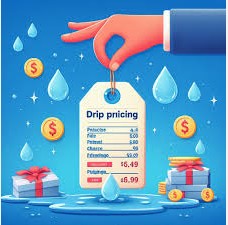Context:
Recently, the Central Government warned the public about “Drip Pricing”, saying it can surprise consumers with hidden charges.
About Drip Pricing

- Drip pricing is a strategy where only a portion of an item’s cost is initially displayed, with the full amount revealed later during the purchase process.
- The charges often involve withholding essential fees like local taxes or booking charges, or omitting necessary add-ons like internet access or amenities, which may be required for product or service usage.
- The price you first see advertised, whether in an email, on a website, or in print (called the “headline price”), might not be the final amount you pay.
- Businesses often show a lower starting price but then add mandatory fees later, so you end up paying more than expected.
- This practice makes it harder to compare prices and isn’t fair to sellers who are upfront about their prices.
- Government advised to seek assistance if they encounter such surges in charges on a product’s MRP (maximum retail price).
- Misinformation warning: When the represented price is inaccurate, it can lead consumers to make misinformed decisions and can result in unfair outcomes for honest competitors.
- Why companies indulge in Drip Pricing- Businesses use drip pricing to draw clients through beginning with a decreased price, and hoping that they’ll keep with the acquisition even after seeing extra charges later.

